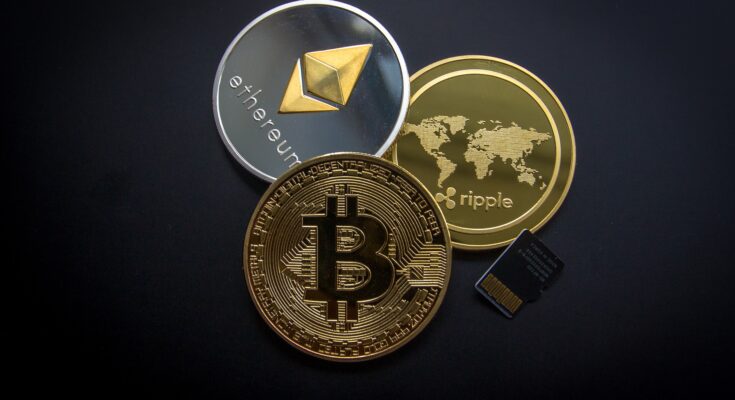What is Bitcoin?
Bitcoin is a digital or virtual currency that uses cryptography (What is Cryptocurrency? How Cryptocurrency Works? How To Buy Cryptocurrency ?) to secure its transactions and control the creation of new units. It was invented in 2008 by an anonymous individual or group using the pseudonym Satoshi Nakamoto and launched in 2009.
It is based on a decentralized, peer-to-peer network that allows for fast, secure, and low-cost transactions without the need for a central authority or intermediary like a bank.
The supply of Bitcoin is limited to 21 million units, with approximately 18 million currently in circulation, which is programmed into the blockchain and cannot be changed.
Bitcoins can be bought and sold on exchanges, and can also be used to purchase goods and services from merchants that accept it as payment or they can be mined by users who use powerful computers to solve complex mathematical puzzles that verify transactions on the blockchain and earn them new Bitcoins as a reward.
Bitcoin has been subject to significant price volatility and regulatory uncertainty, with its value soaring to new heights in late 2017 before experiencing a sharp decline in early 2018. Despite these fluctuations, many people continue to see Bitcoin as a potential alternative to traditional currencies and a store of value.
Bitcoin’s Blockchain Technology
The blockchain technology used in Bitcoin is called the Bitcoin blockchain. Bitcoin’s blockchain technology is a decentralized, digital ledger that records all transactions on the Bitcoin network. It is a transparent, secure, and tamper-proof system that allows for secure transactions without the need for a central authority.
The blockchain is made up of blocks, which are groups of transactions that are verified and recorded by network nodes through a process called mining. Each block contains a cryptographic hash of the previous block, which creates a chain of blocks, hence the name “blockchain.”
Once a transaction is recorded on the blockchain, it cannot be altered or deleted, making it an immutable record of all Bitcoin transactions. This makes the blockchain a transparent and secure way to record transactions and ensures the integrity of the Bitcoin network.
Bitcoin’s blockchain technology has several advantages over traditional payment systems. For one, it is faster and more cost-effective than traditional payment systems, which can be slow and expensive. It also provides a high level of security and transparency, making it ideal for online transactions.
In addition to Bitcoin, blockchain technology has numerous other applications, such as supply chain management, voting systems, and decentralized finance (DeFi). The potential uses for blockchain technology are vast and continue to be explored and developed by researchers and developers around the world.
How To Mine Bitcoin?
Mining ( refers to the process of using computational power to validate transactions and create new blocks on the blockchain.) Bitcoin( https://www.investopedia.com/tech/how-does-bitcoin-mining-work/) involves using specialized computer hardware to solve complex mathematical problems, which in turn validates transactions and creates new blocks on the blockchain. Here are the basic steps to mine Bitcoin:
1. Get the necessary equipment: To mine Bitcoin, you will need a mining rig, which is a computer system with specialized hardware designed for mining Bitcoin. This includes ASIC (Application-Specific Integrated Circuit) chips, which are designed specifically for mining Bitcoin.
2. Join a mining pool: To increase your chances of successfully mining Bitcoin, it is best to join a mining pool. A mining pool is a group of miners who work together to mine Bitcoin and share the rewards. By joining a mining pool, you will have a better chance of earning a reward, although the reward will be shared among all members of the pool.
3. Install mining software: Once you have your equipment and have joined a mining pool, you will need to install mining software on your computer. The software will help you connect to the mining pool and start mining Bitcoin.
4. Start mining: Once your mining software is set up, you can start mining Bitcoin. The mining software will use your computer’s processing power to solve mathematical problems, and the mining pool will validate the solutions and distribute the rewards among the members.
5. Withdraw your earnings: Once you have earned bitcoin from mining, you can withdraw it to your personal Bitcoin wallet. Make sure to keep your private keys safe and secure, as losing them could result in the loss of your Bitcoin.
What amount of time Does It Require to Mine One Bitcoin?
The time it takes to mine one Bitcoin depends on several factors, including the mining hardware used, the mining difficulty, and the current hash rate of the Bitcoin network. Seen in some cases, mining one bitcoin can take from 10 minutes to 30 days, depending on the hardware and software used.
The mining difficulty of Bitcoin adjusts every 2016 block, or roughly every two weeks, to maintain a consistent rate of block production. This means that the time it takes to mine one Bitcoin can vary over time.
In the early days of Bitcoin, it was possible to mine a Bitcoin using a standard computer CPU. However, as the network has grown and become more secure, the difficulty of mining has increased significantly. Today, specialized mining hardware called ASICs (Application-Specific Integrated Circuits) are typically used to mine Bitcoin.
It is important to note that mining Bitcoin can be an expensive and time-consuming process, and may not be a viable option for most individual miners. Many miners choose to join mining pools, where multiple miners pool their resources and share in the rewards. This can increase the chances of successfully mining a Bitcoin, although the rewards will be shared among the members of the pool.
How to Make Money Investing in Bitcoin?
Investing in Bitcoin can potentially provide an opportunity for making money. Here are some ways to potentially make money investing in Bitcoin:
1. Buy and hold: One of the simplest ways to make money investing in Bitcoin is to buy and hold the cryptocurrency for the long term. This means purchasing Bitcoin with the intention of holding onto it for a significant period of time, with the hope that its value will increase over time.
2. Trading: Another way to potentially make money with Bitcoin is to trade the cryptocurrency on exchanges. This involves buying and selling Bitcoin at different prices in order to profit from price movements. Trading can be risky, as Bitcoin’s value is volatile and can fluctuate rapidly.
3. Mining: As mentioned earlier, mining involves using specialized hardware to validate transactions on the Bitcoin network and earn newly created coins and transaction fees. Mining can be profitable if done correctly, but it requires significant investment in hardware and electricity.
4. Investing in Bitcoin-related companies: There are many companies that are involved in the Bitcoin ecosystem, such as exchanges, payment processors, and mining hardware manufacturers. Investing in these companies can potentially provide exposure to the growth of Bitcoin and the wider cryptocurrency industry.
Risk of investing in Bitcoin
Like any investment, investing in Bitcoin carries certain risks. Here are some of the main risks associated with investing in Bitcoin:
1. Volatility: Bitcoin is known for its volatility, which means its value can fluctuate rapidly and significantly in a short period of time. This can lead to large gains or losses for investors and can make it difficult to predict the future value of Bitcoin.
2. Regulation: Bitcoin operates outside of traditional financial systems and is not backed by any government or central authority. This lack of regulation can lead to uncertainty and potential risks for investors, as governments and financial institutions may seek to regulate or restrict the use of Bitcoin.
3. Cybersecurity: As a digital asset, Bitcoin is vulnerable to cyber-attacks and theft. If a hacker gains access to a Bitcoin wallet or exchange, they can steal Bitcoin or manipulate the market in other ways.
4. Adoption: While Bitcoin has gained significant mainstream adoption in recent years, it is still not widely accepted as a form of payment and is not yet considered a mainstream investment. This lack of adoption could limit the potential for Bitcoin’s growth and value in the future.
5. Competition: Bitcoin is not the only cryptocurrency, there are many other digital assets that compete with Bitcoin for market share and investor attention. These competitors could potentially reduce demand for Bitcoin and limit its growth potential.
Overall, investing in Bitcoin carries risks that should be carefully considered before making an investment. It is essential for investors to do their own research, seek professional advice and understand the potential risks and rewards before investing in Bitcoin or any other cryptocurrency.




One Comment on “What is Bitcoin? Which Blockchain Technology Used? How To Mine Bitcoin?”